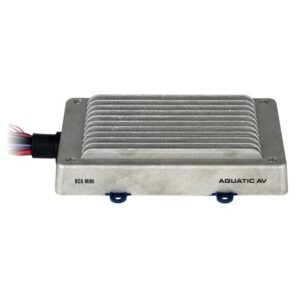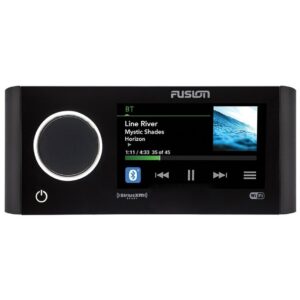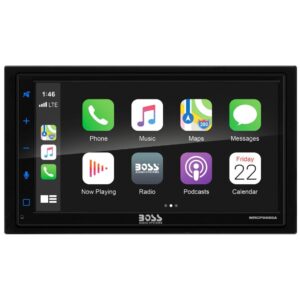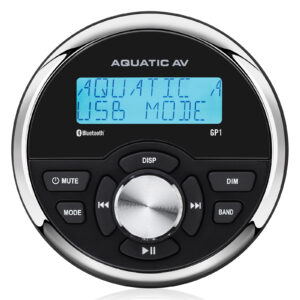As technology has improved, marine stereos have undergone a transformation. No longer are you limited to a 7″ x 2″ x 7″ box. Now stereos are available in many shapes and sizes and the available features are even more diverse. Count on the fact that there is sure to be a model that fits your situation, but how do you determine what that is?
1) Installation Size
Are you replacing an existing stereo? If so, your original unit will leave a cutout hole for you to fill. The size of that cutout will greatly influence your choice. Mounting plates and adapter plates are not readily available, so it is important to find something that will fit in your existing hole.
Standard DIN size is about 7″ x 2″ and there was a time when most stereos came with those dimensions. That is no longer the case, so you can’t take that for granted, but a large percentage still do. Many waterproof stereos have a DIN sized chassis, but a larger faceplate that overlaps the installation surface, so that is something to take into account as well.
A new trend is toward stereos designed almost exclusively for playing music from digital media sources like phones and MP3 players. Since a CD player is not required, many of these units have made a radical departure from the old standards in terms of size. Some are round and gauge size with a shallow mounting depth. They look more like a mounted remote than a traditional stereo. Others are rectangular and thin requiring a cutout more like 3″ x 5″. Yet another new style of stereo is called a “black box” stereo. It consists of a small box that contains the amplifier, radio and all the wiring connections. It is controlled by a waterproof wired remote that is nice and small and can be conveniently mounted.
The important thing to remember is to check the measurements of the stereo you are purchasing against what you already have. Otherwise you might find yourself with installation problems. Even if you are doing a new install, installation measurements can be critical.
2) Marine Stereo Power Output
Unless you are planning on using an external amplifier, the next main consideration should be the power output of the stereo.
There are 2 ways to measure power output. Peak power is the amount of power that the unit can produce at any given instant. RMS or continuous power is the average amount of power that the unit can put out over time. Obviously, the average is going to be lower than the peak output so RMS is actually the more important number. Unfortunately, lower numbers are not nearly as impressive as higher numbers when it comes to wattage, so most manufacturers publish the peak power of their products and simply ignore the RMS.
A good quality marine stereo will put out 40 to 60 watts of peak power per channel. Since most stereos have 4 channels you are looking at a total peak power output of 160 watts to 240 watts. That translates to a range of about 15 watts to 25 watts of RMS continuous power per channel.
That is actually plenty of power for most small boat installations. But if you are picky about sound quality and/or want lots of volume, you should consider an external amplifier. Stereo head units with more than 240 watts of peak power are hard to find.
If you only power 2 speakers with your stereo, then you will only be using half the power. One way to double your volume is to simply add 2 more speakers for a total of 4.
On the other hand, if you need to power more than 4 speakers, you will want to look into an external amplifier as well. It is not usually a good idea to try to power more than one speaker from a single head unit channel unless your stereo is specifically designed for it. You could do some damage to your stereo and your speakers.
3) Features
Often stereos will be similar in size and power and your choice comes down to features. Here is a look at various available features:
- CD Player It wasn’t long ago that all stereos were expected to have a CD player, but those days are long gone. While CD players can still be found, in many cases connectivity to digital media devices like iPods and MP3 players have become the dominant source of music for a stereo. If you don’t need one, you don’t have to have one anymore, so don’t take it for granted that a marine stereo will have a CD player built in.
Looking for a CD changer? Forget it! All manufacturers have discontinued CD changers. Even a small MP3 player can play continuous music for many hours more than any CD changer could. Most stereos that will play standard audio CDs can also play CDs with MP3 files burned onto them. You can burn a lot of hours of music onto a CD in MP3 format. If you are old fashioned and still like to listen to your CD collection, you will have to do it one CD at a time.
- Waterproof You might assume that all marine stereos are waterproof, but that is not the case. All marine stereos have coated circuit boards to prevent corrosion in a humid environment, plus they are UV resistant. Beyond that, only some are completely resistant to rain and splashing. If you know your stereo will get wet, you will want to check the specifications to make sure it can handle it. Also consider that a stereo might only be partially waterproof such as when the faceplate is sealed, but the chassis is not. That could be a problem if water gets behind your dash.
- Device Connectivity Do you plan to use a smart phone or other device for your source of music? It is important to know what will connect with your stereo and how. Most marine stereos have some form of auxilliary audio input. Usually they have a 3.5 mm input jack (that is the same size as a headphone input jack on an iPod). Aux audio input patches the sound from your device into the stereo, but it does not recharge or control your device. Many units have a USB port for connecting devices and they can recharge and control most smart phones and mp3 players. However, Apple requires proprietary software for iPods and iPhones so just because a stereo has a USB port, it does not mean it will work with Apple devices. Again, it is important to look at the stereo specifications so you can be sure it connects to your device the way you want it to.
Most marine stereos offer Bluetooth connectivity which is wireless streaming, usually from a smart phone to the stereo. This feature is enormously convenient, but there are a few things to consider. Your phone will not be recharged if it is not connected via USB, so you’ll need to make allowances for the battery life. Bluetooth only works within about a 30 foot range, so you’ll want to keep that in mind. Fortunately, that is plenty for most boats. Lastly, Bluetooth is a radio signal and all radio signals are subject to interference from a variety of things.
- Satellite Radio Sirius and XM used to be competing satellite radio providers, but they merged a few years ago into SiriusXM. SiriusXM retains control of satellite radio hardware so even if your stereo says “satellite ready” in the specifications, you will always need to buy a separate receiver kit and an antenna in order to enable that feature. There are several types of receiver kits available, so it is important to make sure you get one that is compatible with your stereo.
- Wireless or Wired Remotes Remote controls are usually sold separately and come in several forms. Marine remote controls are always waterproof. A wired remote can be mounted in a convenient location and it is possible to use more than one. For example, your stereo may be in the cabin, but you want a remote at the helm and perhaps one on the swim platform. Marine Wireless remotes are now usually RF (radio frequency) type remotes which means they do not need to be pointed at your stereo to work and they will work through obstructions like walls. The IR (infra red) remotes with which we are all familiar to control our TVs don’t usually work very well in direct sunlight. Some will float when dropped in the water.





